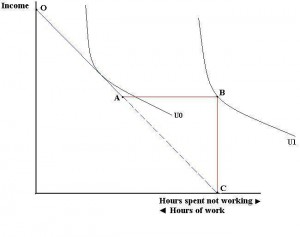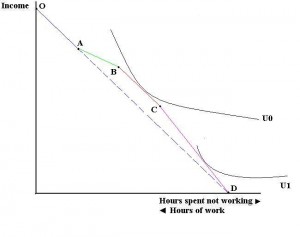One of the most contentious issues of the past couple of decades has regarded policy debates on how to benefit lower-income individuals (colloquially referred to as ‘Welfare’ programs). This article will not deal with the benefits or disadvantages of Welfare programs in general, but instead will compare the various forms of implementing Welfare. Also, I will show (in the next article) a very important unintended consequence that arises from the current preferred Welfare program, the Earned Income Tax Credit.
There have been many different ideas for welfare programs over the years, but most that have been taken with any sense of sincerity have fallen into these three categories:
a.) Direct Payment
b.) Living Wage Laws
c.) Earned Income Tax Credit
A.) Direct Payment
A direct payment form of welfare takes many forms, but the most realistic of which is giving an amount of $X to anybody making under $Y a year to bring them up to $Y a year. Initial reactions to this indicate that this would be the worst form of welfare. Firstly, anybody who earns in the range affected will have no reason to continue working: they will receive the same amount whether they work zero hours a week or not. This is clearly not ideal for a welfare program. Also, for the amount of money spent it is highly inefficient. The encouragement for working more is to earn less money, so the incentives is to work less and then receive the money from the government, which will even further the burden on the government.

Traditional Welfare programs encourage less hours worked. (From Wikipedia)
Some counterarguments may be to set a certain level of income such that when it is reach a bequeath of money is received. This reaches the same problem as the $0 minimum problem. The incentive will only be to reach the amount of money required for the welfare and then stop earning such that the money will be provided by the government as opposed to the employer. This form of welfare, not surprisingly, is virtually nonexistent in most forms today (some would argue that Medicaid is a form of this, however). As is evident from even the most basic analyses, this form of welfare would certainly increase unemployment (or decrease employment hours)
B.) Living Wage Laws
The next two forms of welfare are a little bit more legitimate than the direct payment form and both are seen in some form in different parts of the country. Living wage laws are mandated minimums on wages (generally above the minimum wage) that are mandated not through legislation, but through ordinances. This is dones such that (usually) only companies that receive government contracts or include government employees are affected. Legally, this is a very shrewd maneuver, such that it is persuasive enough to affect wages without mandating it, while still ‘holding oneself’ to a higher standard.
The problem in this, however, is also clear. Budgetary responsibilities place the onus of the operation on the taxpayers to increase the wages of these employees. Increased competition will thus occur at these jobs, and employees may be rotated so that only the most efficient and capable workers are worth the extra cost for salary.
This method is exacerbated even further when you compare those who receive the living wage laws with those who are not affected, their competitors. In order to compete with the higher wages given to their competitors, the current companies will need to raise prices to combat an increased labor cost and turnover. This will feed its way through to the local community in the form of inflation (a very limited form of it, indeed). On a more philosophical level, this method also seems to fail. If the meaning of helping underpriveleged or underrepresented citizens is to benefit those who need it most, then why are we benefitting some and not others? It seems rather difficult to justify as a governmental institution: the claim to be helping the poor, but ignoring other working poor. This is, again, based on the assumption that this is worth doing in the first place, which is very easy to contest. Also, living wage laws have the same crowdout and deadweight loss problems that any other price minimum (price as a wage in this sense) or price maximum mandate has, which will generally increase unemployment (or decrease employment hours).
C.) The Earned Income Tax Credit
The Earned Income Tax Credit is a favorite amongst Economists. The EITC is structured such that for the first couple thousand dollars a citizen makes, he or she is reimbursed with extra money to encourage working further. Once a certain income level is reached, the extra welfare is stopped. And when another income level is reached, the welfare starts decreasing to the point that it is back again at $0. For example, in the year of 2007 for a single mothter with one child, she will receive and extra $0.34 per dollar earned for her first $8,391 of wages. After that she will receive no extra aid between $8,392 and $15,399 of wages. From $15,400 to $33,240 of wages, the single mother will have her benefit decrease by $0.1598 to the point where she is not receiving any more welfare.

EITC maintains working incentives. (From Wikipedia)
Why is this better than the direct payment method? Firstly, it is not a simple bequeath that is given to a certain point. Throughout the whole spectrum of expected wages, there is always a reason to earn more money (in the example above, $1.34 at first, then $1, then $0.8402). In the previous example, this is not the case. Thus, the incentive is not only to have people work, but it decreases the burden on the taxpayers as opposed to more traditional methods. There has been much speculation that the EITC decreases unemployment but also decreases employment hours. This argument is made based off of the part of the phaseout where somebody affected by the EITC would be only earning $.8402 per dollar earned. Thus, there are many instances where people in this range could earn more money with less hours than before the change to the EITC. Thus, it is possible that any avoidance of unemployment done by this method is simply shifting employment hours among the current working poor.
Comparing the Living Wage Laws and the Earned Income Tax Credit gives the following observations:
Earned Income Tax Credit affects more people
Earned Income Tax Credit should cause less unemployment (though again the argument for the employment shift could be made)
Earned Income Tax Credit will cause less local inflation due the federal nature of the program
These three reasons are the major reasons that the EITC is preferred to almost any other method of welfare suggested, especially the minimum wage. There is one part of the structure of the Living Wage law that is a huge advantage over the EITC: liquidity. I will discuss the liquidity and its unintended consequences next time.
Cheers,
Cameron Daniels
